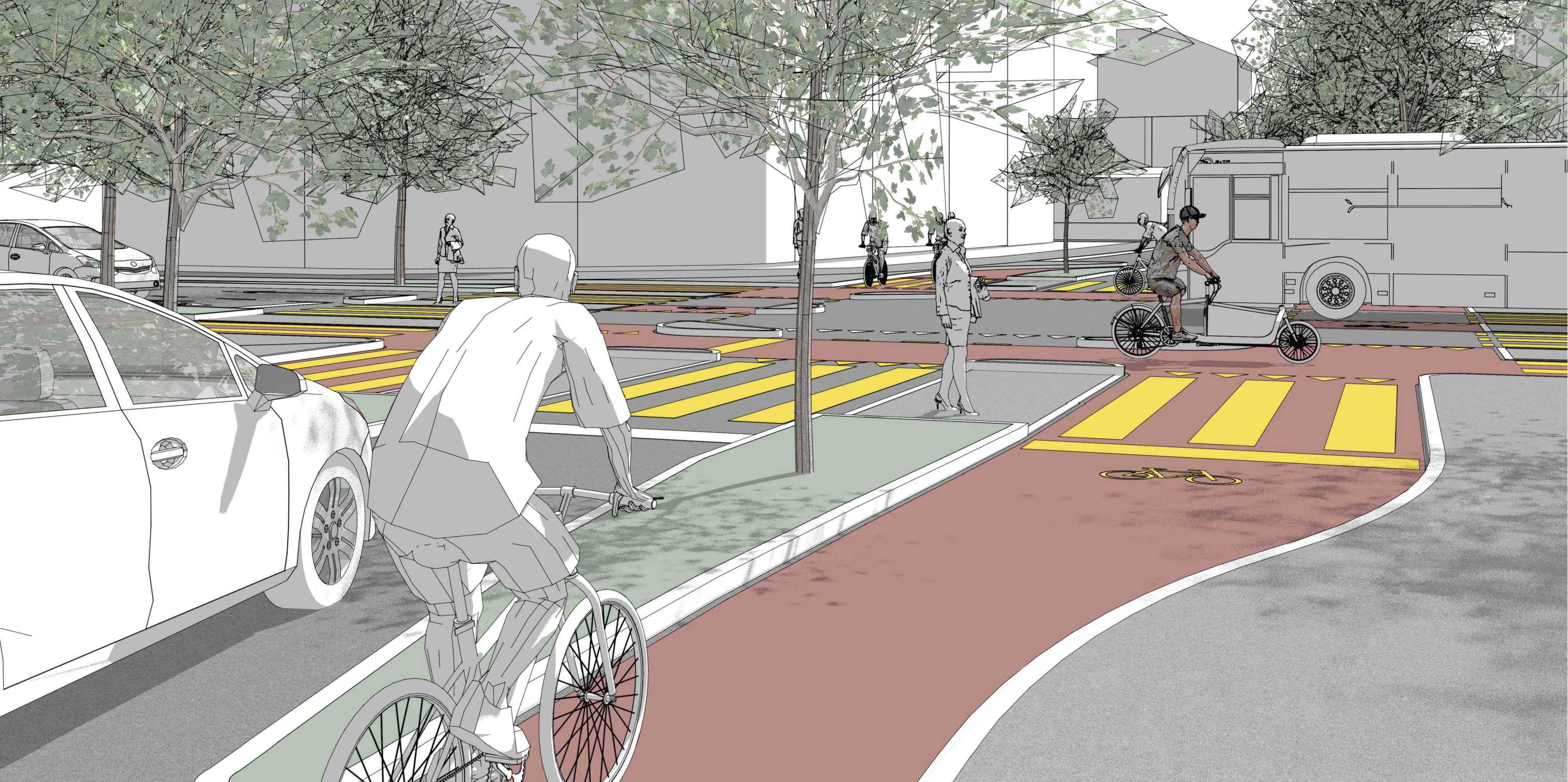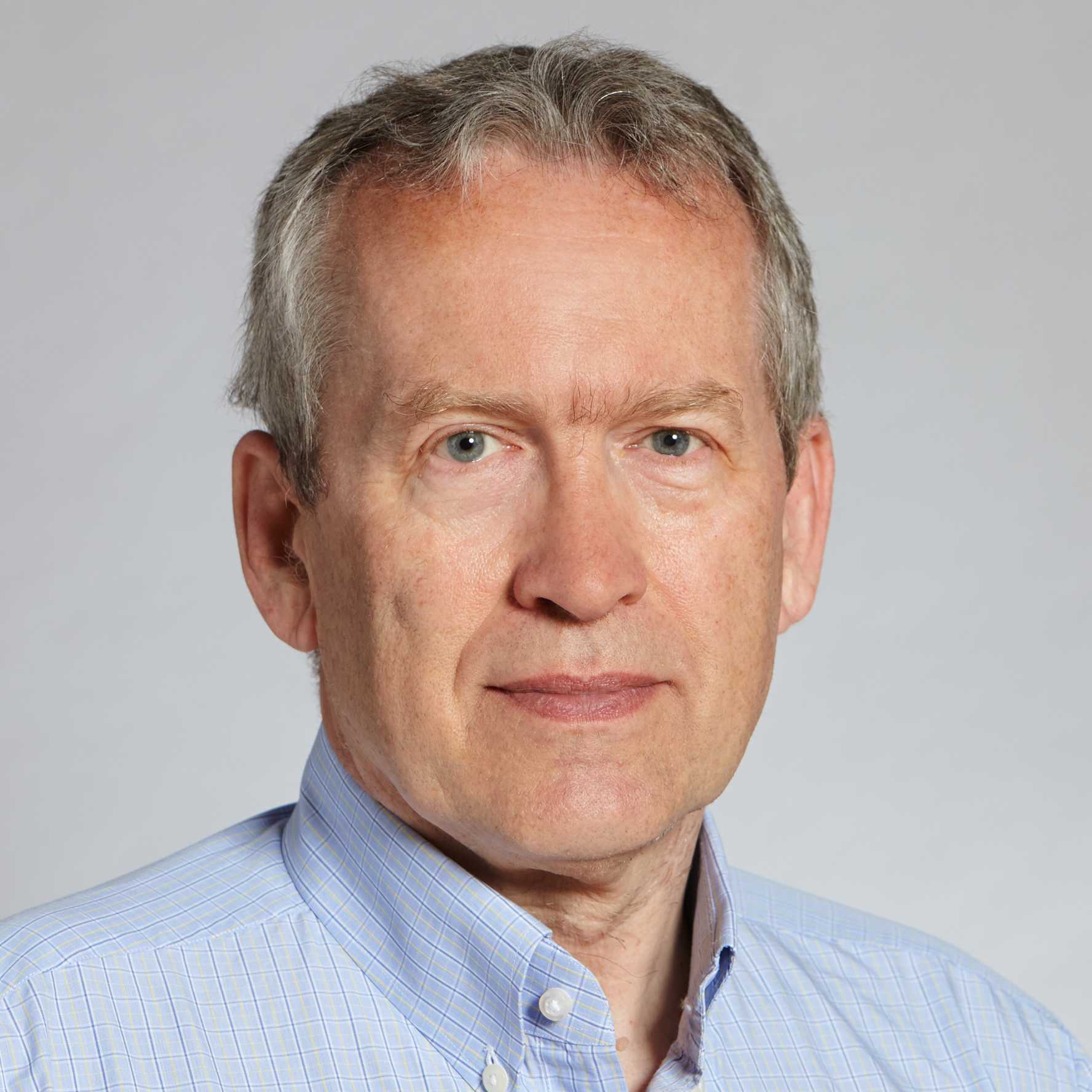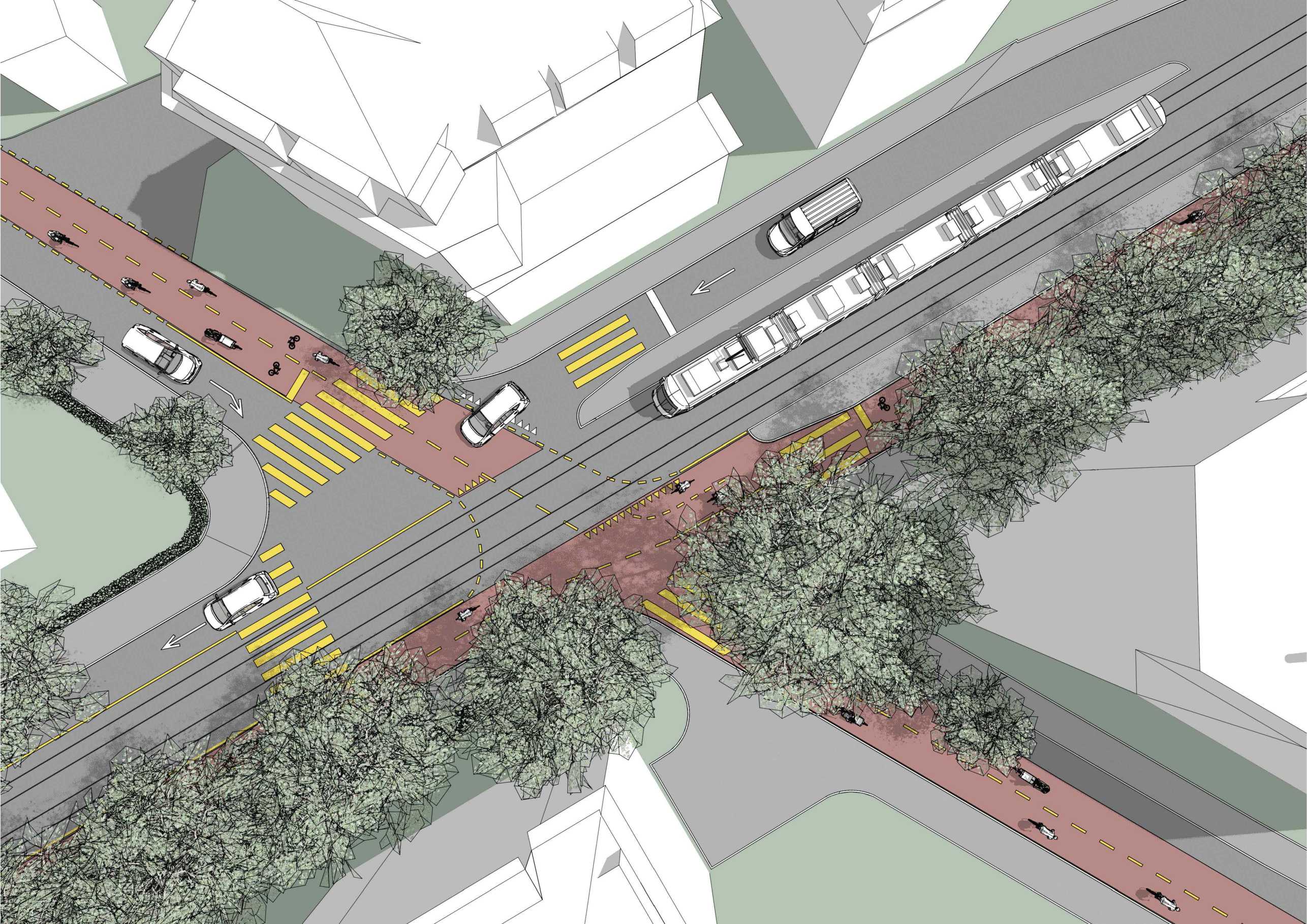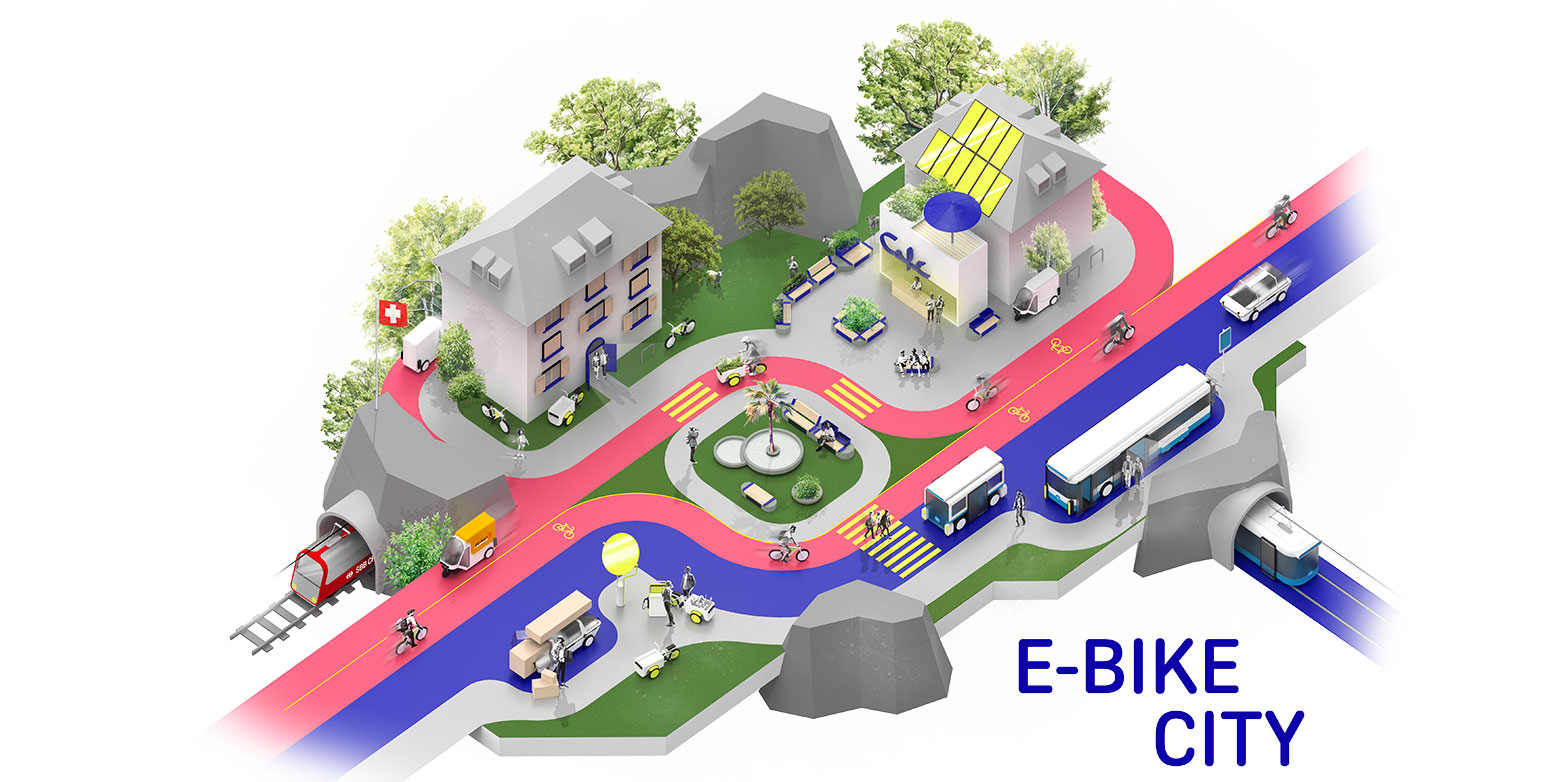How Zurich has to change its roads to have more e-bikes than cars
What happens when cities gear their road space primarily to the needs of cyclists and e-bikers? On a new popular-science website, ETH researchers from the Department of Civil, Environmental and Geomatic Engineering use examples from the city of Zurich to show what such an “E-Bike City” could one day look like.

In brief
- The E-Bike City is a vision of what cities could look like if they took half their street space and gave it back to pedestrians, cyclists and e-bikers.
- The research project examines how viable the principles of the E-Bike City are and what conditions are necessary for possible conversion.
- Today, over 80 percent of urban street space is reserved for cars and car parking. The ETH researchers found that 37 percent of Zurich’s streets today are suitable for conversion to bike lanes, pavement and green spaces.
What would the streets look like if a city took half its traffic space and gave it to cycling and e-biking? Would city dwellers use their bikes more often? Might the concept of an “E-Bike City” even be a way to help reduce transport-related CO2 emissions?
Nine professorships at ETH Zurich and EPF Lausanne have been investigating these questions for a good year and a half. This research initiative is led by transport researcher Kay Axhausen, who is retiring in January 2024 (see box). The initial findings are now available, and the researchers have visualised their solutions and published them this week on a story-map website. Story mapping presents the vision of the E-Bike City as a story in text and images, making it easy to understand.
In a future E-Bike City, people will be able to use half the city’s road space when they are out and about on foot or travelling by bicycle, e-bike, cargo bike, e-scooter or other small modes (what’s known as micromobility). Today, over 80 percent of urban street space is reserved for cars and car parking; only about 11.7 percent is earmarked for e-bikes and bicycles. For the most part, cyclists and e-bikers share the roads with cars.
More space for people instead of cars
In the E-Bike City, by contrast, the lanes for cars, public transport (trams, buses), two-wheelers (bicycles, e-bikes) and the pavement for pedestrians would generally be separated from each other. Rather than widening roads or building new ones, this would involve repurposing the existing space. The E-Bike City’s road network would largely consist of single-lane, one-way streets, with lanes for bikes and e-bikes usually located to the left and right of the one-way street. Public transport, meanwhile, would continue to use its existing separate lanes. “A redesign like this would give more space back to people,” Axhausen says.
To present the innovations of the E-Bike City as realistically as possible, the researchers selected three typical examples from the city of Zurich: Bellevue square and Quaibrücke bridge near Lake Zurich, Birchstrasse in north Zurich and Winterthurer-/Letzistrasse in the Oberstrass district. Using these examples, they show how different a street would look if it were designed to be bike-friendly instead of car-friendly. An image comparison slider can be used to directly compare the current road space and its possible future state.
The design of the E-Bike City follows certain principles. Based on the existing road network, one half of each road is converted into a safe and comfortable cycle lane that can be used by bikes, e‑bikes, cargo bikes, e-scooters, etc. The other half of the road is still used for cars (petrol- or battery-powered), so access to residential and office buildings is guaranteed.
Four steps to an e-bike-friendly Bellevue
On their story-map website, the ETH researchers use the example of Zurich’s Bellevue square and Quaibrücke bridge to show how the E-Bike City principles could be implemented in four steps:
- Step 1: Public transport, which currently crosses the Quaibrücke bridge in one lane in the middle, will still have right of way. Most of the tram tracks and bus lanes remain unchanged. Where separate tram and bus lanes are not possible, shared lanes with cars ensure a seamless public transport network.
- Step 2: The road network for cars provides access to every building so that all important access routes (e.g. for tradespeople, people with mobility issues or physical disabilities), emergency services (ambulance, fire brigade, police) and deliveries are possible.
- Step 3: The remaining street space is used for micromobility as well as for wider pavements and new green spaces. The ETH researchers found that 37 percent of Zurich’s streets today are suitable for conversion along these lines.
- Step 4: The more city dwellers who subsequently decide to live car-free, the more parking spaces can gradually be converted into bicycle parking, greenery and playgrounds. Sufficient loading zones and short-term parking spaces ensure access for emergency, delivery and transport vehicles.
Dynamic road use combats congestion
In addition to these key actions, the ETH and EPFL researchers are investigating further measures. For example, the switch to a one-way urban road network might cause congestion, but dynamic road use could reduce the probability of that happening. Depending on the time of day, traffic signals could be used to control the direction in which cars and bicycles use the road and how many lanes they can occupy. The team is also looking into how road users will accept the E-Bike City; for example, motorists may feel disadvantaged if cyclists are given priority. “In the research project, we’re examining how viable and cost-effective the basic assumption and principles of the E-Bike City are, and what conditions are necessary for possible conversion,” Axhausen says.
Closer to politics than ever before
For Axhausen, the E-Bike City project also marks the end of his career as Professor of Transport Planning at ETH Zurich, although he will continue to supervise the project following his retirement. Having joined ETH in 1999, Axhausen earned a reputation as a researcher who delves deep into transport issues with a keen analytical eye and precise economic and mathematical models.
One particular achievement was the MATSim transport simulation system, which he and his research group have helped to develop over the past 20 years. Axhausen says the system has had “a major, resounding impact.” Today, MATSim can simulate numerous aspects of traffic behaviour. “The largest application that we can currently simulate in a reasonable computing time covers the whole of Germany – that’s the transport decisions of 85 to 90 million people.”

“Our vision is to make the city of the future more comfortable, quieter, greener and healthier than it is today.”Kay Axhausen
Bridging the conflicting goals of transport and climate policy
“As a researcher, I’ve never directly participated in transport policy debates before,” says Axhausen. “But with the E-Bike City project it’s different; we’re actually getting more actively involved in transport policy.” For example, the story-map website and the findings of the E-Bike City project were presented this week to Simone Brander, the Zurich City Council member responsible for transport. This involvement has much to do with climate change, a topic that overshadows many traffic problems, such as the classic traffic jam problem, and requires new solutions.
“In view of global warming, we can’t continue with our previous approach to transport planning. We need new transport policy ideas for cities. The E-Bike City is also a model of how the transport sector can reduce its greenhouse gas emissions,” Axhausen points out. “This project is intended to show that bicycles and e-bikes can serve as a standard means of transport in the city. Our vision is to make the city more comfortable, quieter, greener and healthier than it is today.”
Kay Axhausen’s retirement: Colloquium and lecture
Dr Kay W. Axhausen (born 1958), currently Full Professor of Transport Planning at the Department of Civil, Environmental and Geomatic Engineering, is retiring at the end of January 2024.
Professor Axhausen will give his farewell lecture, “Visions and dilemmas”, on 7 December 2023, 5.15–6.30 p.m., in the Audi Max at ETH Zurich. Further information
The lecture is part of the Network City and Landscape’s three-day colloquium, “Transport planning – Where do we go now?”, 6–8 December 2023. Further information and registration



